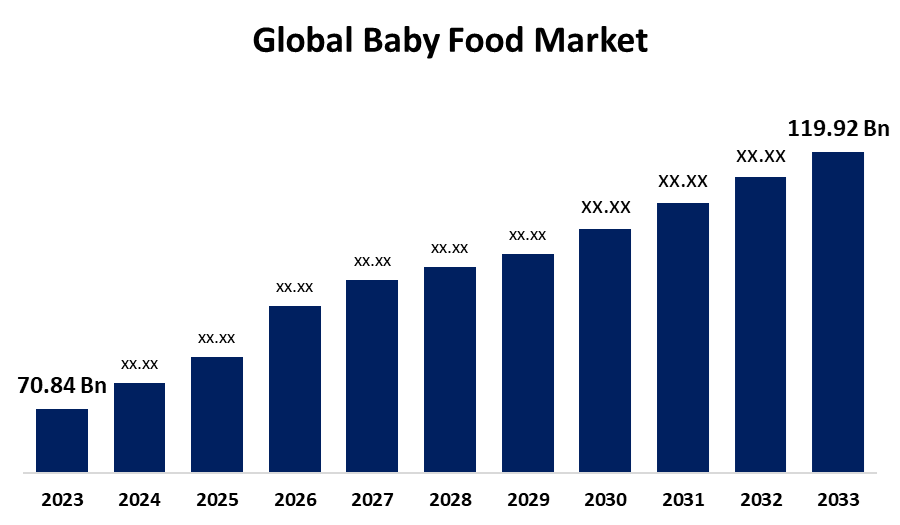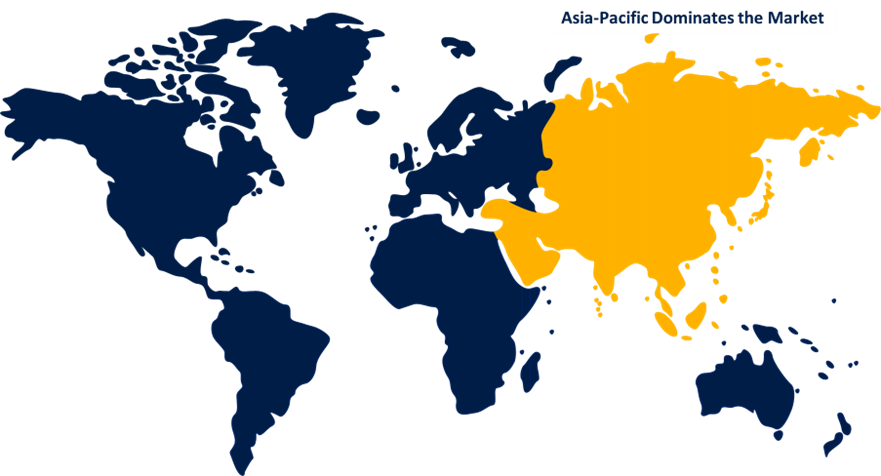Global Baby Food Market Size, Share, and COVID-19 Impact Analysis, By Category (Organic and Conventional), By Type (Milk Formula, Dried, Ready-to-Feed, Others), By Distribution Channel (Drugstores/ Pharmacies, Supermarkets/Hypermarkets, Convenience Store) and By Region (North America, Europe, Asia-Pacific, Latin America, Middle East, and Africa), Analysis and Forecast 2023 - 2033.
Industry: Food & BeveragesGlobal Baby Food Market Insights Forecasts to 2033
- The Global Baby Food Market Size was Valued at USD 70.84 Billion in 2023
- The Market Size is Growing at a CAGR of 5.41% from 2023 to 2033
- The Worldwide Baby Food Size is Expected to Reach USD 119.92 Billion by 2033
- Europe is expected to grow the fastest during the forecast period.

Get more details on this report -
The Global Baby Food Market Size is anticipated to exceed USD 119.92 billion by 2033, growing at a CAGR of 5.41% from 2023 to 2033.
Market Overview:
Baby food is easily digestible soft food designed primarily for newborns and toddlers aged six months to two years old. Baby food comes in a wide range of flavors, kinds, and shapes. It might be mashed table food or something easily available and purchased from a producer. The worldwide baby food business is expanding rapidly as the number of working women rises, as are parental worries about nutrition. Professionally prepared baby food has helped busy mothers manage their time. These meals are given to babies between the ages of four to six months and two years. The rise in understanding of newborns' increasing nutritional demands, coordinated retail marketing, and a large spike in the female workforce are the primary drivers for the baby food industry expansion. Increased urban population and lifestyle changes as disposable incomes rise are significant reasons driving worldwide baby food industry growth. Furthermore, growth in female employment leaves less time for food preparation and nursing newborns, increasing the demand for high-quality baby foods.
Report Coverage:
This research report categorizes the market for global baby food based on various segments and regions forecasts revenue growth and analyses trends in each submarket. The report analyses the key growth drivers, opportunities, and challenges influencing the global baby food market. Recent market developments and competitive strategies such as expansion, product launch, and development, partnership, merger, and acquisition have been included to draw the competitive landscape in the market. The report strategically identifies and profiles the key market players and analyses their core competencies in each sub-segment of the global baby food market.
Global Baby Food Market Report Coverage
| Report Coverage | Details |
|---|---|
| Base Year: | 2023 |
| Market Size in 2023: | USD 70.84 billion |
| Forecast Period: | 2023-2033 |
| Forecast Period CAGR 2023-2033 : | 5.41% |
| 2033 Value Projection: | USD 119.92 billion |
| Historical Data for: | 2019-2022 |
| No. of Pages: | 223 |
| Tables, Charts & Figures: | 121 |
| Segments covered: | By Category, By Type, By Distribution, By Region |
| Companies covered:: | Bubs Australia Limited, HiPP, PZ Cussons, Nestlé, The Hain Celestial Group, Inc, Abbott Laboratories, Asahi Group, Symrise AG, DMK Group GmbH, Friesland Campina, Kewpie Corporation, Reckitt Benckiser Group plc, Danone S.A, Milupa GmbH, The Kraft Heinz Company, Hero Group, and Others. |
| Pitfalls & Challenges: | Covid-19 Empact, Challenges, Growth, Analysis |
Get more details on this report -
Driving Factors:
The demand for organic baby food is growing as the number of working mothers has grown in recent decades. There is a high demand for these convenience meals, which is driving market expansion. This sector is projected to increase since it saves time and allows women to maintain a work-life balance while doing household tasks.
Restraining Factors:
Stringent quality tests and directives from governments and food departments place major constraints on the infant food sector.
Market Segmentation:
The global baby food market share is classified into product and application.
- The organic segment has the highest share of the market during the forecast period.
Based on the category, the global baby food market is categorized into organic and conventional. Among these, the organic segment has the highest share of the market during the forecast period. Organic baby food provides critical elements such as vitamins, minerals, and antioxidants, which are necessary for a child's general health. Organic puree is excellent for introducing solid meals to a baby's diet. Puree is made by mixing fruits, vegetables, and, in some cases, meat or grains. It comes in a variety of tastes and can be readily put in a bag or jar for eating on the go.
- The ready-to-feed segment is expected to drive the growth of the market over the forecast period.
Based on the type, the global baby food market is categorized into milk formula, dried, ready-to-feed, and others. Among these, the ready-to-feed segment is expected to drive the growth of the market over the forecast period. Ready-to-eat meals save time that could have been spent purchasing, cooking, and cleaning up. The ready-to-eat infant food product generates the most money. It contains oatmeal, purees, and squash. All of these foods are ready to consume. The category is predicted to expand as the number of working women in the global economy rises.
- The supermarkets/hypermarkets segment has the largest share of the market during the projected timeframe.
Based on the distribution channel, the global baby food market is categorized into drugstores/ pharmacies, supermarkets/hypermarkets, and convenience stores. Among these, the supermarkets/hypermarkets segment has the largest share of the market during the projected timeframe. The hypermarket or supermarket category is likely to hold the biggest proportion of the entire market. Supermarkets are predicted to expand throughout the projection period due to the high awareness and attractiveness of these food products among the population of Asia Pacific. This area offers aggressive marketing and attractive pricing strategies.
Regional Segment Analysis of the Global Baby Food Market
- North America (U.S., Canada, Mexico)
- Europe (Germany, France, U.K., Italy, Spain, Rest of Europe)
- Asia-Pacific (China, Japan, India, Rest of APAC)
- South America (Brazil and the Rest of South America)
- The Middle East and Africa (UAE, South Africa, Rest of MEA)
Asia-Pacific is projected to hold the largest share of the global baby food market over the forecast period.

Get more details on this report -
Asia-Pacific is projected to hold the largest share of the global baby food market over the forecast period. The Asia Pacific market generated the most revenue in previous years and is predicted to show promising improvements throughout the forecast period. The market is predicted to develop as the number of working women increases and more people become aware of various baby food items that give nourishment and protect the health of their children. The market is expected to increase throughout the projected period due to its wide distribution choices and powerful marketing channels.
Europe region is also expected to fastest CAGR growth during the forecast period. The European region has a high number of raw material sources for infant food. Stringent restrictions and fierce rivalry among producers have resulted in product variety and increased nutritional value. The big firms are actively involved in mergers and acquisitions to get a competitive advantage.
Competitive Analysis:
The report offers the appropriate analysis of the key organizations/companies involved within the global baby food market along with a comparative evaluation primarily based on their product offering, business overviews, geographic presence, enterprise strategies, segment market share, and SWOT analysis. The report also provides an elaborative analysis focusing on the current news and developments of the companies, which includes product development, innovations, joint ventures, partnerships, mergers & acquisitions, strategic alliances, and others. This allows for the evaluation of the overall competition within the market.
List of Key Companies:
- Bubs Australia Limited
- HiPP
- PZ Cussons
- Nestlé
- The Hain Celestial Group, Inc
- Abbott Laboratories
- Asahi Group
- Symrise AG
- DMK Group GmbH
- Friesland Campina
- Kewpie Corporation
- Reckitt Benckiser Group plc.
- Danone S.A.
- Milupa GmbH
- The Kraft Heinz Company
- Hero Group
- Others
Key Market Developments:
- In October 2024, Nestle announced that it is launching 14 new Cerelac baby food varieties free of refined sugar. This comes after a scandal in which it was discovered that, in contrast to markets in Europe or the UK, Cerelac in developing nations, particularly India, included additional sugars.
Key Target Audience
- Market Players
- Investors
- End-users
- Government Authorities
- Consulting And Research Firm
- Venture capitalists
- Value-Added Resellers (VARs)
Market Segment
This study forecasts revenue at global, regional, and country levels from 2020 to 2033. Spherical Insights has segmented the global baby food market based on the below-mentioned segments:
Global Baby Food Market, By Category
- Organic
- Conventional
Global Baby Food Market, By Type
- Milk Formula
- Dried
- Ready-to-Feed
- Others
Global Baby Food Market, By Distribution Channel
- Drugstores/ Pharmacies
- Supermarkets/Hypermarkets
- Convenience Store
Global Baby Food Market, By Regional
- North America
- US
- Canada
- Mexico
- Europe
- Germany
- Uk
- France
- Italy
- Spain
- Russia
- Rest of Europe
- Asia Pacific
- China
- Japan
- India
- South Korea
- Australia
- Rest of Asia Pacific
- South America
- Brazil
- Argentina
- Rest of South America
- Middle East & Africa
- UAE
- Saudi Arabia
- Qatar
- South Africa
- Rest of the Middle East & Africa
Frequently Asked Questions (FAQ)
-
What is the CAGR of the global baby food market over the forecast period?The global baby food market size is expected to grow from USD 70.84 Billion in 2023 to USD 119.92 Billion by 2033, at a CAGR of 5.41 % during the forecast period 2023-2033.
-
Which region is expected to hold the highest share in the global baby food market?Asia-Pacific is projected to hold the largest share of the global baby food market over the forecast period.
-
Who are the top key players in the baby food market?Bubs Australia Limited, HiPP, PZ Cussons, Nestlé, The Hain Celestial Group, Inc, Abbott Laboratories, Asahi Group, Symrise AG, DMK Group GmbH, Friesland Campina, Kewpie Corporation, Reckitt Benckiser Group plc, Danone S.A, Milupa GmbH, The Kraft Heinz Company, Hero Group, and Others
Need help to buy this report?